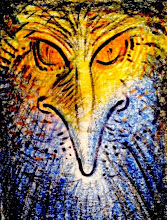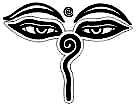
Spring 2008
University of Connecticut
School of Fine Art
Art 113
Introduction to Aesthetics
Philosophy of Consciousness,
Media Ecology
and Theory of Art
Dr. Justin Good
vood@cummings-good.com
(617) 733-9270
Section 001: Mondays and Wednesdays, 6 – 7:15 PM
Section 002: Tuesdays and Thursdays 7:30 – 8:45 PM
We meet in Room AB106.
COURSE DESCRIPTION
This course offers an introduction to the philosophical discipline of aesthetics as the ecology of perception. While term is often used to mean beautiful or pleasing to the senses, the word aesthetics carries a broader meaning, derived from the Greek word aesthesis which simply means sensation. The discipline of aesthetics, which began in the 1800s, was conceived of as the study of perception, and it studied the arts as involving a special kind of perception. We shall be approaching the study of aesthetics in a broader and more exciting sense as the interdisciplinary study of perception, involving such disciplines as information theory, philosophy of art, media ecology, consciousness studies and ecological design.
AIMS AND INTENTIONS
While this is a philosophy class, it is designed for art students and is meant primarily to stimulate the artistic and design work of the student by introducing her, in a systematic and holistic way, to the theoretical study of perception. By learning the many ways that visual experience and visual images can be questioned, the student is given conceptual resources for discovering new expressive possibilities that her work can take. When all of its possibilities are unlocked, art can be a powerful force for change in the world.
OUR CONCEPTUAL MAP
This course is designed as a story of concepts, a continuous unfolding of questions and ideas which begins with the simplest (but still very complicated!) concept – perception – and goes on to address increasing levels of complexity and cultural meaning.
I. Perception
II. Mediated Perception
III. Aesthetic Mediated Perception
IV. Environmental Aesthetic Mediated Perception
The following outline of our philosophical inquiry into perception and art indicates some ways that answering basic questions about what it means to see requires that we address many other difficult philosophical questions about human life and existence.
What does it mean to see?
(1) TO SEE means (2) TO PERCEIVE which necessarily involves (3) BEING INFORMED and hence (4) BEING SELECTIVE of some larger domain of information, and hence, (5) BEING BLIND to other aspects of the collection, which requires both (6) KNOWLEDGE, as the purpose of gathering information, as well as grasping the (7) MEANING of what is experienced, and also (8) CONSCIOUSNESS of what is being gathered, which needs to be understood as an (9) EVOLUTIONARY PROCESS taking place within the even larger context of the (10) NATURAL WORLD, which we experience through a form of life called (11) HUMAN CULTURE, and more specifically,(12) WESTERN CIVILIZATION, which has shaped perception most directly through its (13) MEDIA TECHNOLOGIES, which must themselves be understood ecologically as (14) COMMUNICATION ENVIRONMENTS, within which we live, whereas (15) ART is a special way of approaching our communication environments by creating (16) ARTWORKS, which are a special kind of production which induces (17) AESTHETIC MEDIATED PERCEPTION involving the use of (18) REPRESENTATIONS of reality, but representations of a special kind which concern (19) THE FORM of the experience or object which interests (20) THE ARTIST, who is a person interested in this kind of experience, which has (21) AESTHETIC PROPERTIES which bear mysterious relationships to (22) TRUTH and also (23) GOODNESS and to the (24) NATURE OF THE SELF, and which have been given very powerful interpretations by (25) MODERNISM as a theory of culture and a way of life, which has in turn shaped our (26) ARCHITECTURAL LANDSCAPE in ways which are (27) ALIENATING but also (28) LIBERATORY and WHOLENESS ENHANCING and which hold open the possibility for (29) SUSTAINABLE LIVING and a revolutionary new (30) ECOLOGICAL CONCEPT OF BEAUTY, which helps us to understand in a new way (31) WHAT IT MEANS TO SEE (1)
Together we shall build a conceptual map with which to navigate the amazing ways that questions about perception ramify throughout every dimension of human life and specifically, the life of the Artist.
COURSE REQUIREMENTS
1. Three projects for the class on selected problems we will discuss and explore during the seminar. (60%)
2. Student participation in class discussions (30%).
3. Some short writing assignments (10%).
4. Regular Attendance.
REQUIRED TEXTS
1. Arthur C. Danto, The Transfiguration of the Commonplace: A Philosophy of Art (Harvard University Press, 2006) ISBN-10: 0674903463.
2. Albert Borgmann, Holding On to Reality: The Nature of Information at the Turn of the Millennium (University Of Chicago Press, 2000) ISBN-10: 0226066231
3. Ken Wilber, The Eye of Spirit: An Integral Vision for a World Gone Slightly Mad (Shambhala, 2001) ISBN-10: 1570628718.
Recommended: Patricia Wallace, The Psychology of the Internet (Cambridge University Press, 2001); ISBN-10: 0521797098.
In addition there will be a number of online writings • Readings and additional information for each class are posted on the course weblog art113.blogspot.com one class in advance.
COURSE SCHEDULE
What is perception?
1) 1.23 Introduction to aesthetics as the ecology of perception.
2) 1/28 Kinds of blindness
• Oliver Sacks, “The Mind’s Eye: What the blind see”
3) 1/30 Standard model of perception
• Richard Gregory, “Knowledge in perception and illusion”
4) 2/4 The mind-body problem
• Rupert Sheldrake, “The sense of being stared at”
What is awareness?
5) 2/6 Theories of consciousness
• Ken Wilber, The Eye of Spirit
6) 2/11 Perennial philosophy
• The Eye of Spirit cont.
7) 2/13 Blindness project due
• The Eye of Spirit cont.
8) 2/18 Mythos and logos: ways of knowing
• The Eye of Spirit cont.
9) 2/20 Holism and models of the self
• The Eye of Spirit cont.
What is information?
10) 2/25 Introduction to media ecology
• Marshall McLuhan, 1969 Playboy Interview
11) 2/27 Narcissus narcosis
• Handout on Mcluhan’s theory of art
12) 3/3 The concept of “progress”
• Learning from Ladakh, film screening.
• John Zerzan, “Running on Emptiness: The Failure of Symbolic Thought”
13) 3/5 Natural information and pre-literate experience
• Albert Borgmann, Holding On to Reality
Spring break
14) 3/17 Cultural meaning and the sociological imagination
• Holding On to Reality cont.
15) 3/19 Technological information
• Holding On to Reality cont.
16) 3/24 Narcissus narcosis project due
• Holding On to Reality cont.
What is art?
17) 3/26 Plato’s challenge to artists: The relation of beauty to truth
• Handout on Plato’s Republic.
18) 3/31 Metaphysics of art objects
• Arthur Danto, Transfiguration of the Commonplace
19) 4/2 Realism and the riddle of style
• Transfiguration cont.
• Handout on ten concepts of realism
20) 4/7 Art history and the end of art
• Transfiguration cont.
21) 4/9 Aesthetic objects and transfiguration
• Transfiguration cont.
22) 4/14 Modernist concepts of beauty and design
• Handout on Kant’s and Duchamp’s aesthetics
23) 4/16 Holonic theory of art
• The Eye of Spirit, “Integral Art and Literary Theory”
What is wholeness?
24) 4/21 Design flaws of hydrocarbon society
• The End of Suburbia, film screening
• Richard Heinberg, “What will we eat as the oil runs out?
25) 4/23 Aesthetics of wind farms
• Justin Good, “The Cosmology of Beauty”
26) 4/28 Theory of form as unfolding wholeness
• Handout on Christopher Alexander’s theory of architecture
27) 4/30 Wholeness project due




